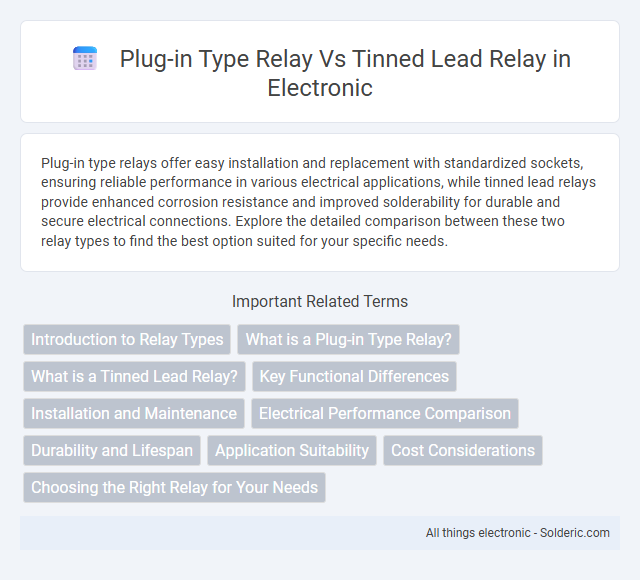Plug-in type relays offer easy installation and replacement with standardized sockets, ensuring reliable performance in various electrical applications, while tinned lead relays provide enhanced corrosion resistance and improved solderability for durable and secure electrical connections. Explore the detailed comparison between these two relay types to find the best option suited for your specific needs.
Comparison Table
| Feature | Plug-in Type Relay | Tinned Lead Relay |
|---|---|---|
| Connection Type | Socket-based, easy insertion and removal | Soldered tinned leads, permanent connection |
| Installation | Quick and tool-free | Requires soldering tools and skills |
| Maintenance | Easy replacement without desoldering | Replacement requires desoldering |
| Reliability | Good, but contact may loosen over time | High reliability due to solid soldered connection |
| Cost | Typically higher due to socket hardware | Generally lower cost |
| Application | Prototyping, frequent replacement | Permanent installations, high vibration environments |
Introduction to Relay Types
Plug-in type relays are designed for easy installation and replacement, featuring standardized pin configurations that fit into socket bases, allowing for straightforward maintenance and system upgrades. Tinned lead relays, on the other hand, utilize tinned wire leads for direct soldering onto printed circuit boards, offering secure electrical connections and reliability in compact electronic assemblies. Both relay types serve distinct applications, with plug-in relays favored in modular systems and tinned lead relays preferred for permanent PCB integration.
What is a Plug-in Type Relay?
A Plug-in Type Relay is an electromechanical switch designed for easy installation and replacement through a socket interface, enhancing maintenance efficiency in electrical circuits. It typically features standardized pin configurations that enable quick removal without soldering, making it ideal for industrial automation and control systems. This relay type contrasts with Tinned Lead Relays, which require soldered connections, offering more permanent installations but less flexibility for swapping components.
What is a Tinned Lead Relay?
A Tinned Lead Relay is an electromagnetic switch featuring leads coated with a thin layer of tin to enhance conductivity and prevent corrosion. This tinning process ensures reliable electrical connections and extends the relay's operational lifespan in various industrial and automotive applications. Compared to plug-in type relays, tinned lead relays offer better durability in harsh environments but require soldering for installation rather than a socket connection.
Key Functional Differences
Plug-in type relays offer easy installation and replacement through socket mounting, ensuring quick maintenance and reduced downtime, while tinned lead relays feature soldered leads for permanent circuit connections, providing enhanced vibration resistance and durability. The plug-in design is ideal for applications requiring frequent relay swaps or testing, whereas tinned lead relays suit environments with steady, long-term operation demands. Understanding these key functional differences helps you select the appropriate relay based on installation convenience and operational reliability.
Installation and Maintenance
Plug-in type relays offer streamlined installation with simple socket mounting, reducing downtime during replacements and minimizing wiring errors. Tinned lead relays require precise soldering, increasing installation time and complicating maintenance due to the need for desoldering and resoldering connections. Your choice impacts maintenance efficiency and installation speed, with plug-in relays providing easier serviceability in high-turnover environments.
Electrical Performance Comparison
Plug-in type relays typically offer faster switching speeds and higher current handling capabilities compared to tinned lead relays, making them ideal for applications requiring rapid and reliable electrical performance. Tinned lead relays, while generally more cost-effective, may exhibit slightly higher contact resistance and shorter lifespan under high-load conditions due to their lead composition. Your choice between these relay types should consider the specific electrical load demands and the importance of switching efficiency in your application.
Durability and Lifespan
Plug-in type relays offer enhanced durability with robust mechanical connections designed to withstand repeated insertions and withdrawals, contributing to a longer operational lifespan in industrial applications. Tinned lead relays benefit from corrosion-resistant tinned leads that improve solder joint reliability and reduce oxidation, extending the relay's effective service life, especially in harsh environmental conditions. Your choice between these relays depends on specific durability needs, where plug-in types excel in mechanical robustness and tinned lead versions provide superior protection against environmental degradation.
Application Suitability
Plug-in type relays offer easy replacement and maintenance, making them ideal for industrial automation systems requiring frequent service and modular assembly. Tinned lead relays provide superior corrosion resistance and enhanced solderability, suited for harsh environmental conditions and long-term reliability in electronic circuitry. Selecting between these relays depends on the specific application demands, such as ease of installation versus environmental durability.
Cost Considerations
Plug-in type relays generally have a higher initial purchase cost due to their modular design and ease of replacement, which can reduce long-term maintenance expenses. Tinned lead relays tend to be less expensive upfront but may increase overall costs because of their more labor-intensive installation and potential for higher failure rates. Your decision should weigh the balance between upfront investment and operational efficiency to optimize total cost of ownership.
Choosing the Right Relay for Your Needs
Selecting the right relay involves evaluating specific application requirements such as durability, ease of replacement, and environmental exposure. Plug-in type relays offer convenient installation and quick swapping suitable for systems requiring frequent maintenance. Tinned lead relays provide enhanced corrosion resistance and better solderability, making them ideal for harsh environments and permanent installations.
Plug-in Type Relay vs Tinned Lead Relay Infographic

 solderic.com
solderic.com